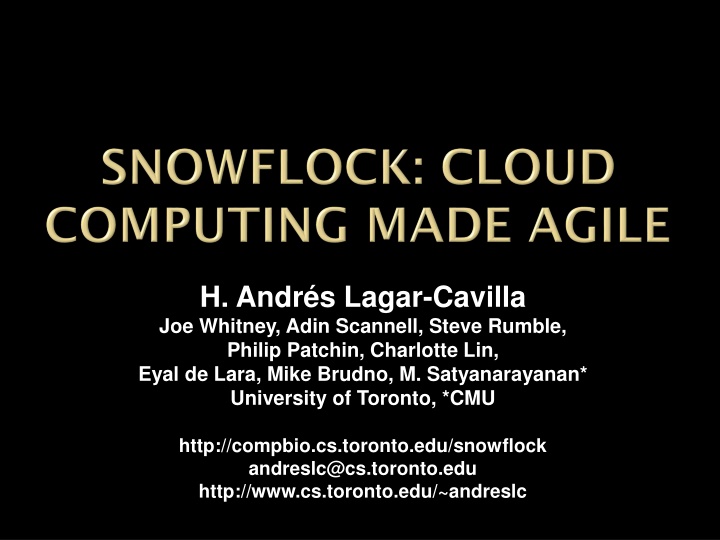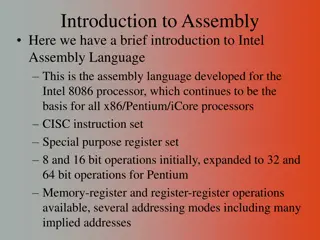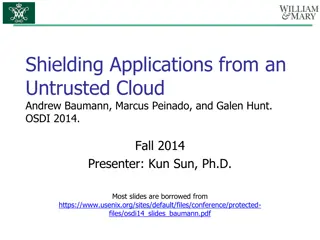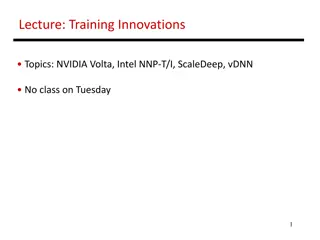
Efficient Parallel Computing in Virtual Environments
Discover innovative approaches for parallel computing through virtual machine cloning and impromptu clusters, enabling rapid completion of tasks with near-interactive response times. Explore the potential for embarrassingly parallel tasks across various domains, from bioinformatics to quantitative finance, revolutionizing cluster management and optimizing resource utilization in institutional environments.
Download Presentation

Please find below an Image/Link to download the presentation.
The content on the website is provided AS IS for your information and personal use only. It may not be sold, licensed, or shared on other websites without obtaining consent from the author. If you encounter any issues during the download, it is possible that the publisher has removed the file from their server.
You are allowed to download the files provided on this website for personal or commercial use, subject to the condition that they are used lawfully. All files are the property of their respective owners.
The content on the website is provided AS IS for your information and personal use only. It may not be sold, licensed, or shared on other websites without obtaining consent from the author.
E N D
Presentation Transcript
H. Andrs Lagar-Cavilla Joe Whitney, Adin Scannell, Steve Rumble, Philip Patchin, Charlotte Lin, Eyal de Lara, Mike Brudno, M. Satyanarayanan* University of Toronto, *CMU http://compbio.cs.toronto.edu/snowflock andreslc@cs.toronto.edu http://www.cs.toronto.edu/~andreslc
(The rest of the presentation is one big appendix) Virtual Machine cloning Same semantics as UNIX fork() All clones are identical, save for ID Local modifications are not shared API allows apps to direct parallelism Sub-second cloning time Negligible runtime overhead Scalable: experiments with 128 processors
Impromptu Clusters: on-the-fly parallelism Pop up VMs when going parallel Fork-like: VMs are stateful Near-Interactive Parallel Internet services Parallel tasks as a service (bioinf, rendering ) Do a 1-hour query in 30 seconds Cluster management upside down Pop up VMs in a cluster instantaneously No idle VMs, no consolidation, no live migration Fork out VMs to run un-trusted code i.e. in a tool-chain etc
GATTACA GACATTA CATTAGA AGATTCA Sequence to align: GACGATA GATTACA GACATTA CATTAGA AGATTCA Another sequence to align: CATAGTA
Embarrassing Parallelism Throw machines at it: completion time shrinks Big Institutions Many machines Near-interactive parallel Internet service Do the task in seconds NCBI BLAST EBI ClustalW2
Embarrassing Parallelism Throw machines at it: completion time shrinks Big Institutions Many machines Near-interactive parallel Internet service Do the task in seconds NCBI BLAST EBI ClustalW2 Not just bioinformatics Render farm Quantitative finance farm Compile Farm (SourceForge)
Dedicated clusters are expensive Movement toward using shared clusters Institution-wide, group-wide cluster Utility Computing: Amazon EC2 Virtualization is a/the key enabler Isolation, security Ease of accounting Happy sys admins Happy users, no config/library clashes I can be root! (tears of joy)
Impromptu: highly dynamic workload Requests arrive at random times Machines become available at random times Need to swiftly span new machines The goal is parallel speedup The target is tens of seconds VM clouds: slow swap in Resume from disk Live migrate from consolidated host Boot from scratch (EC2: minutes ) 400 NFS Multicast 300 Seconds 200 100 0 0 4 8 12 16 20 24 28 32
Fork copies of a VM In a second, or less With negligible runtime overhead Providing on-the-fly parallelism, for this task Nuke the Impromptu Cluster when done Beat cloud slow swap in Near-interactive services need to finish in seconds Let alone get their VMs
Impromptu Cluster: On-the-fly parallelism Transient 0: Master VM Virtual Network 3:CATTAGA 1:GACCATA 2:TAGACCA 4:ACAGGTA 5:GATTACA 6:GACATTA 7:TAGATGA 8:AGACATA
Impromptu Cluster API Programmatically direct parallelism sf_request_ticket Talk to physical cluster resource manager (policy, quotas ) Modular: Platform EGO bindings implemented Hierarchical cloning VMs span physical machines Processes span cores in a machine Optional in ticket request
sf_clone Parallel cloning Identical VMs save for ID No shared memory, modifications remain local Explicit communication over isolated network sf_sync (slave) + sf_join (master) Synchronization: like a barrier Deallocation: slaves destroyed after join
tix = sf_request_ticket(howmany) prepare_computation(tix.granted) me = sf_clone(tix) do_work(me) if (me != 0) send_results_to_master() sf_sync() else collate_results() sf_join(tix) Split input query n-ways, etc Block scp up to you IC is gone
VM descriptors VM suspend/resume correct, but slooow Distill to minimum necessary Memtap: memory on demand Copy-on-access Avoidance Heuristics Don t fetch something I ll immediately overwrite Multicast distribution Do 32 for the price of one Implicit prefetch
Memory State Mem tap ? Virtual Machine Multicast VM Descriptor VM Descriptor VM Descriptor Metadata Pages shared with Xen Page tables GDT, vcpu ~1MB for 1GB VM Mem tap ?
600 Clone set up Multicast descriptor 500 800 Milliseconds 400 Xend resume code 700 300 600 200 Wait for clones to start Milliseconds 500 100 400 0 300 VM spawn Contact all hosts (from descriptor) 200 Xend suspend code 100 VM suspend (make descriptor) 0
900 800 700 Milliseconds Clone set up Xend (restore) VM restore Contact hosts Xend (suspend) VM suspend 600 500 400 300 200 100 0 2 4 8 16 32 Clones Order of 100 s of milliseconds: fast cloning Roughly constant: scalable cloning Natural variance of waiting for 32 operations Multicast distribution of descriptor also variant
Dom0 - memtap VM paused Maps Page Table 9g056 c0ab6 bg756 776a5 03ba4 9g056 Bitmap R/W bg756 Kick back 0 1 1 1 1 00000 c0ab6 00000 00000 03ba4 00000 9g056 Read-only Shadow Page Table 00000 Kick Hypervisor Page Fault
300 Network (unicast) 250 Microseconds 200 Memtap logic (map page) 150 Context switch to dom0 100 50 SnowFlock in hypervisor Xen hypervisor (shadow PT) 0 Page Fault (HW)
Dont fetch if overwrite is imminent Guest kernel makes pages present in bitmap Read from disk -> block I/O buffer pages Pages returned by kernel page allocator malloc() New state by applications Effect similar to balloon before suspend But better Non-intrusive No OOM killer: try ballooning down to 20-40 MBs
SHRiMP 32 clones, 1GB Memory footprint 9000 Client Requests Sent by Server 8000 Thousands of Pages 7000 Heuristics OFF 6000 Heuristics ON 5000 4000 3000 10K 10K 18K 2000 1000 0 Unicast Multicast Push Multicast Unicast Multicast Push Multicast Network Mode Lockstep: Single reply for many requests Push saves many client requests But push sends more data Sent only 40 Megs!
Client library in VM (C, Python, Shell) Marshall and post requests to Xenstore Shared memory control interface SnowFlock daemon in dom0 Watches Xenstore and posts replies Daemons make up a distributed system Orchestrate cloning, joining Suspend VM to produce descriptor Distribute descriptor Use descriptor to spawn clones
Multicast Sender simple: rate limiting, switch programming Receiver in charge of reliability: time-out, resend Push mode to exploit spatial locality Lockstep awareness Batching multiple page updates SMP-safety Virtual disk Same ideas as memory Virtual network Isolate ICs from one another Yet allow access to select external resources
Fast cloning VM descriptors Memory-on-demand Little runtime overhead Avoidance Heuristics Multicast (implicit prefetching) Scalability Avoidance Heuristics (less state transfer) Multicast
Cluster of 32 Dell PowerEdge, 4 cores 128 total processors Xen 3.0.3 1GB VMs, 32 bits, linux pv 2.6.16.29 Obvious future work Macro benchmarks Bioinformatics: BLAST, SHRiMP, ClustalW Quantitative Finance: QuantLib Rendering: Aqsis (RenderMan implementation) Parallel compilation: distcc
140 Ideal SnowFlock 120 100 Seconds 80 60 40 20 0 Aqsis BLAST ClustalW distcc QuantLib SHRiMP ClustalW: tighter integration, best results 128 processors (32 VMs x 4 cores) 1-4 second overhead
110min 90 80 Ideal SnowFlock 143min 70 87min 61min 60 Speedup 20min 50 40 30 20 7min 10 0 Aqsis BLAST ClustalW distcc QuantLib SHRiMP Measured against ideal with one processor Embarrassing parallelism: hour-long task shrunk to seconds As fast as slowest worker
Four concurrent Impromptu Clusters BLAST , SHRiMP , QuantLib , Aqsis Cycling five times Ticket, clone, do task, join Shorter tasks Range of 25-40 seconds: near-interactive service Evil allocation
40 Ideal SnowFlock 35 30 25 Seconds 20 15 10 5 0 Aqsis BLAST QuantLib SHRiMP Higher variances (not shown): up to 3 seconds Need more work on daemons and multicast
BLAST, heuristics on, but 256MB DB cached in memory 35 Ideal Multicast Multicast + Push Unicast 30 25 Push too aggressive Speedup 20 15 10 5 Unicast doesn t scale 0 0 5 10 15 Clones 20 25 30 35
>32 machine testbed Change an existing API to use ICs MPI in progress: backwards binary compatibility mpirun np 128 -> forks 128 clones Cluster consolidation and management Much much simpler with VM cloning No idle VMs, VMs come up immediately Shared Memory For specific tasks In many workloads, all we need is a shared array Each worker files its results before calling sf_sync
Genomics, Proteomics, Search All exhibit embarrassing parallelism Big-Data Internet services VM allocation cognizant of data availability VM data R/W warms physical node cache Indices created by one IC used by other ICs API porting take 2: Map/Reduce VM modularly/opaquely uses appropriate FS Lustre, Hadoop, PVFS, pNFS Open Data: go to any cloud, crunch the data
SnowFlock clones VMs Fast: 32 VMs in less than one second Scalable: 128 processor job, 1-4 second overhead Addresses cloud computing + parallelism Abstraction that opens many possibilities Impromptu parallelism Impromptu Clusters Near-interactive parallel Internet services Lots of action going on with SnowFlock
andreslc@cs.toronto.edu http://www.cs.toronto.edu/~andreslc http://compbio.cs.toronto.edu/snowflock
Sequence of Amino acids CFGATTGATTACAC
Embarrassing Parallelism Throw machines at a task Time to completion shrinks Loose or no synchronization between parallel workers
Suspend one and resume n - 1GB RAM 400 350 NFS Multicast 300 Seconds 250 200 150 100 50 0 0 4 8 12 16 20 24 28 32 Linear minutes arggh!!
Impromptu: highly dynamic workload Need to swiftly span new machines Near-interactive service: tens of seconds VM clouds have slow swap in Minutes, tens of seconds Impromptu Cluster (IC) Fork copies of a VM In a second, or less With negligible runtime overhead Providing on-the-fly parallelism, for this task Nuke the IC when done
Bioinformatics Rendering Quantitative Finance etc CLOUD COMPUTING UNBOUNDED PARALLELISM VIRTUALIZATION NEAR-INTERACTIVE INTERNET SERVICES IMPROMPTU CLUSTERS VIRTUAL MACHINE PARALLEL FORK
A bit of a kitchen sink abstraction Copy an entire process But quite a comfortable one New stateful computing element Tricks under the hood make it viable COW et al. Same thing for VM cloning
Clone VMs Then fork processes VMs span physical machines Processes span cores in a machine Intuition: better to spawn one 4-vcpu VM then four 1-vcpu VMs Optional One may want to leverage VM cloning only Automated process forking may not fit all needs
Metadata (Xend, virtual I/O devices) Pages shared with Xen Memory management data structures Segmentation: GDT Page Tables: bulk of the descriptor Physical memory addresses canonicalized Machine->physical Loosely constant-sized, small 1MB for a 1GB VM
(paused) Dom0 - memtap VM Maps Page Table 9g056 c0ab6 bg756 776a5 03ba4 9g056 Heuristics Bitmap R/W bg756 Write-only Kick back 1 0 1 1 1 1 00000 9g056 00000 c0ab6 00000 00000 03ba4 Read-only Shadow Page Table 00000 Kick Hypervisor Page Fault
Sender simple Switch programming Rate-limit Receiver in charge of reliability Time out, request again Optional push mode Exploit spatial locality of memory accesses Send x, x+1, x+2 . Lockstep Clone VMs start simultaneously, with a slight skew And access memory similarly, with a slight skew Ignore repeated requests within a small window
Sender simple IGMP group management Tell switch what to do Handshake protocol to add new clients Logic to rate-limit sending Must not overflow receivers Keep receiver averages, drop rate on message drop Optional push mode Exploit spatial locality of memory accesses Send x, x+1, x+2 .
Receiver in charge of reliability Time out, ask again Receiving rate fed back to sender Lockstep avoidance All cloned VMs start from the same instruction With a slight skew Likely to receive n requests for the same page Slightly skewed Send once, ignore the rest for a small window of time
Virtual disk: same principles as memory Multicast distribution Don t fetch if overwrite is imminent Lightly exercised, in general Virtual network: isolation Multiple virtual clusters coexisting Discriminate traffic, avoid address clashes Ebtables filtering Need to access cluster-hosted data, outside world Iptables routing Also automatic IP reconfig based on clone ID
tix = ic_request_ticket(howmany) me = ic_clone(tix) for i in pairs for j in pairs pairwise_align(i,j) send_results_to_master() ic_sync() else collate_results() ic_join(tix)




















